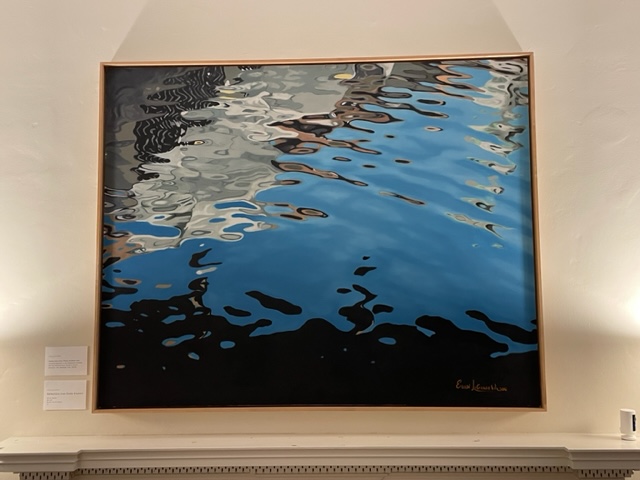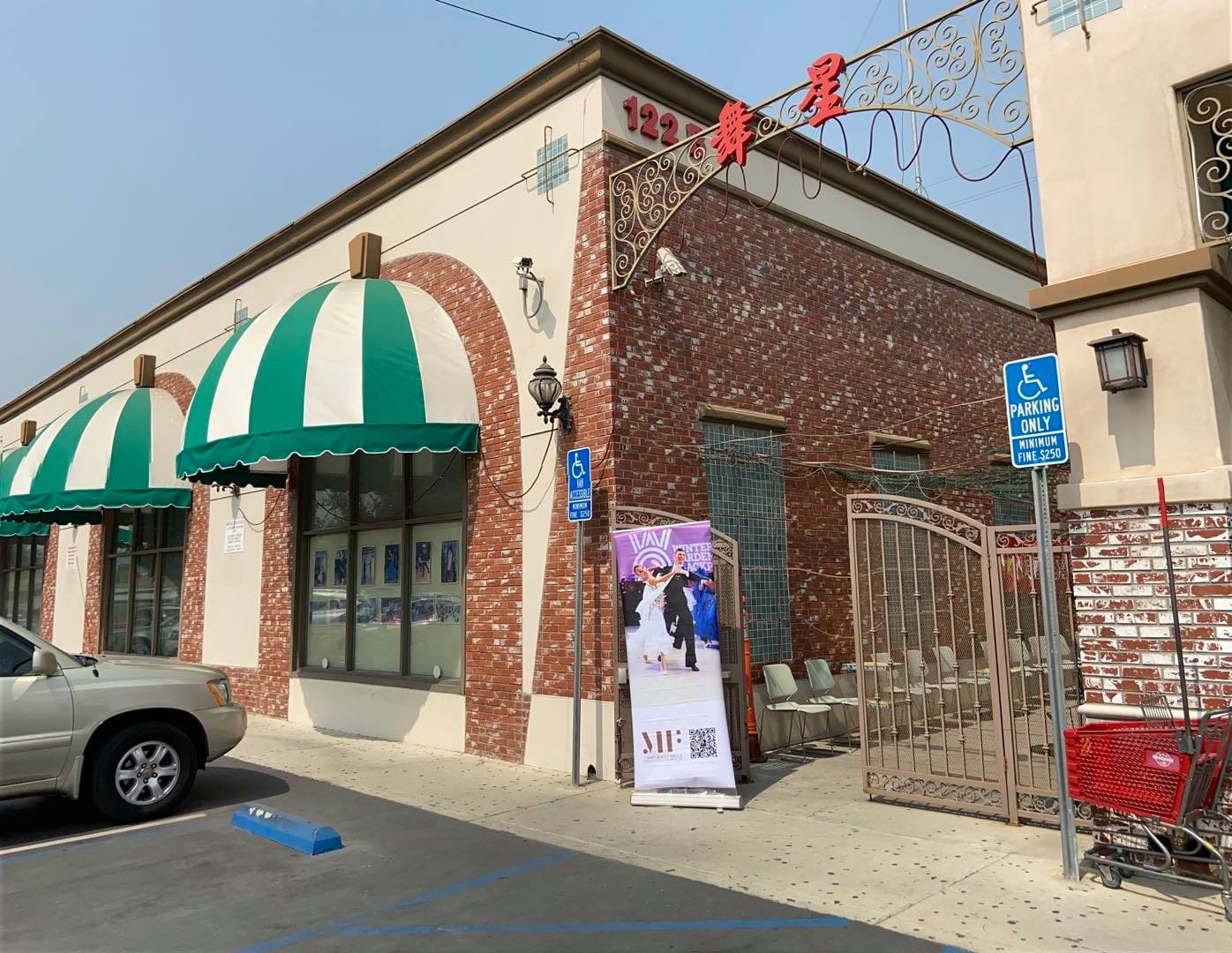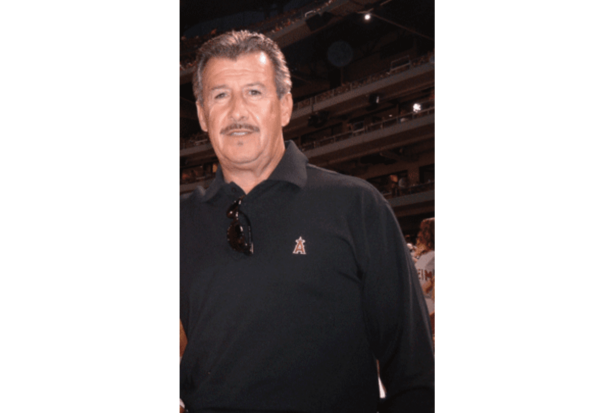By May S. Ruiz
Evan LeGrande Wilson, who founded LeGrande Studios, Inc. over 30 years ago, has built a flourishing practice of creating decorative and fine artworks. His commissioned works have graced the homes of various celebrities and notable personalities like Brad Pitt and Angelina Jolie, Barry Bonds, and Roy Disney, Jr. among others; major institutions including L.A. County Libraries, NASA, Forest Lawn; and several historic churches, hotels, and theaters.
On Dec. 9, 2022, Wilson opened his solo exhibition of cityscapes, landscapes, and portraits at Joann’s Art Space at 1745 Orlando Road in Pasadena. His pieces are available for purchase and can be viewed by appointment only until Feb. 28, 2023 by calling (626) 999-1777. One morning, during a break from the huge winter storm, he graciously agrees to meet for an interview and walkthrough.
Wilson discloses that his painting career began even while he was taking a political science degree at UCLA. He declares, “I had absolutely no interest in political science; I just wanted a degree. While I was in college, I worked for a company that did painting in beautiful homes in Beverly Hills, Bel Air, and other exclusive areas. I worked on Mondays, Wednesday, and Fridays and I went to school on Tuesdays and Thursdays. At first, I worked on glazes and then little by little I got the opportunity to paint something more specific — it could be clouds and skies, flowers or butterflies, etc. It wasn’t [until] after I finished college, though, that I realized I enjoyed painting. So I took some classes at Otis College of Art and Design, then I studied in Europe to improve my artistic abilities.”

Like writers, painters paint what they know. For Wilson, the place where he grew up in rural Utah called Huntington, which then had a population 100 people, holds a special place in his heart and he recently painted a landscape of the farms there. He did another painting for his mother of the area close to where she was raised and where she had gone to school. “She had a graduating class of seven students,” he says.
Travel is a fount of learning and inspiration for many of us, but more so for artists who appreciate what they see and then weave that into their craft. Among the paintings in Wilson’s exhibition are his experiences in Europe. In fact, the source of one of his favorite paintings — “Reflections from Ĉesky Krumlov” — was the Czech Republic. He explains, “I was there taking photos and observing the light at different times of the day and I captured this idea and painted it in oil in the studio. It was actually used as background in a rom-com movie called ‘The Wedding Year’ a couple of years ago.”
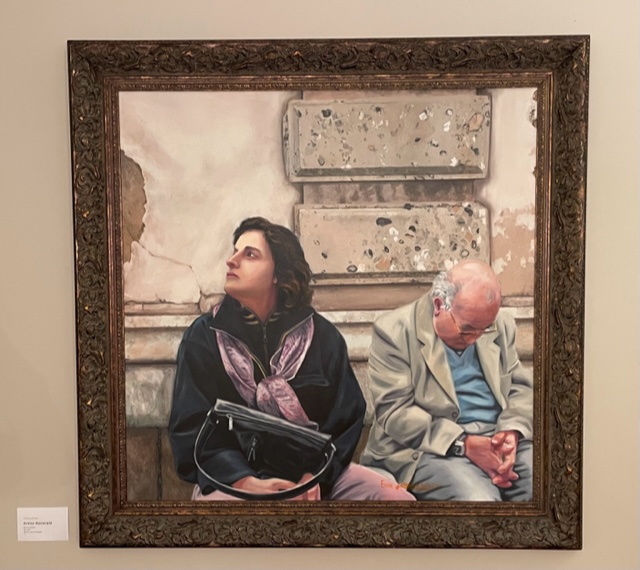
Wilson points to another piece and says, “This was in Paris when there was a train strike and people, including me, were stuck waiting for the next train. The father has fallen asleep and she’s looking up at the sign to check when the train is going to arrive. I changed the background completely. This is what I call a genre painting as opposed to a portrait, a landscape, or a still life — it captures a moment in time.”
There are two pieces of a winter scene in The Netherlands; another is a still life painted in Belgium — “I was with a friend and we just set some things on the table and I started drawing the rough shapes,” Wilson recalls.
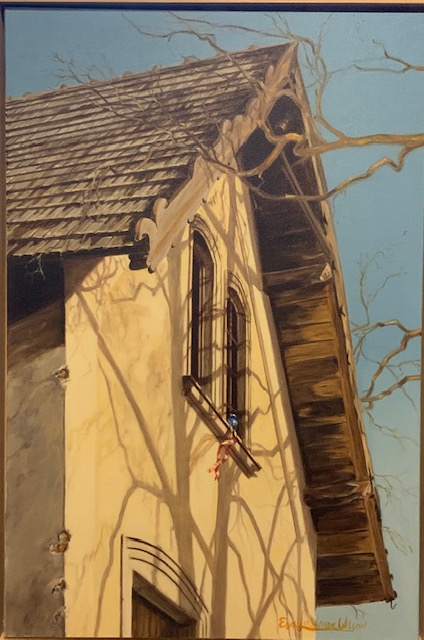
“This painting is that of an ancient deteriorating historic building in Prague in the Czech Republic,” Wilson states. “I put a vase there — something brighter — to give a contrast to the old weathered wood and as a focal point to look at.”

The local scenery also serves as a well of creativity. Wilson reveals, “I often drive around L.A. just to look for interesting views and this one is a cityscape at night; that line of palm trees is near Dodger Stadium. I like the color palettes here going into the shadow tones that aren’t necessarily burnt or raw umber but you see violets. It’s like a study on how you see color as it diminishes as the sun goes down. This won a Best in Show on two different group exhibitions.”
A painting that elicits a lot of positive feedback is called “Sunrise.” Wilson states, “It’s heartwarming and beautiful — it’s meant to evoke that feeling when we go out in the morning as the sun is coming up. There were important paint theory decisions I had to make when I was doing this. One is that I brought the horizon line low which allowed me to strié the sky and create all these layers of color. I also moved the trees to the side because the rays of the sun are coming this way so the position of trees is counterbalanced by the direction of the light.”
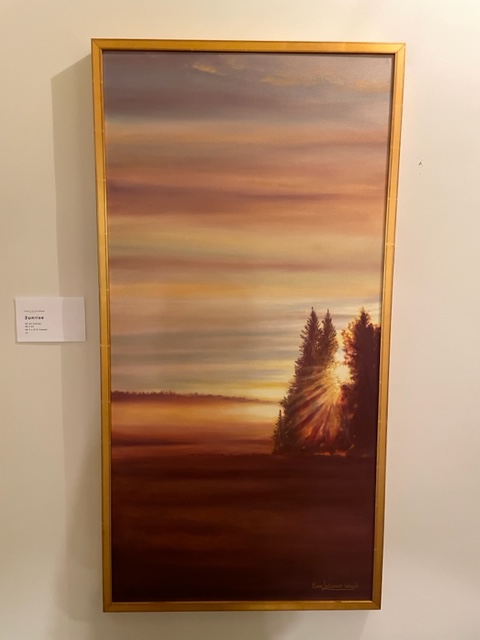
“And going back to color theory, colors that are opposite each other on the color wheel look really good together — they’re called complementary colors for a reason,” Wilson explains further. “That’s why several people responded to this piece during the show. Sometimes we react to things even when we don’t know why we like them. If the trees or the horizon line were right in the center, we’d still like the painting but it wouldn’t have the same effect in our brain, it wouldn’t look as interesting.”
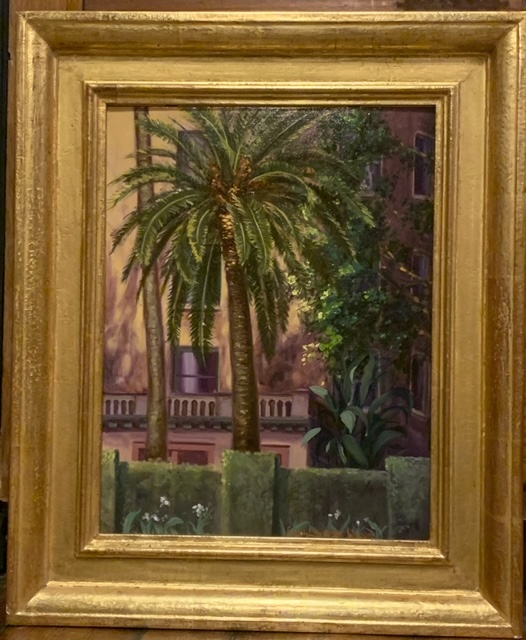
Wilson likes painting trees and remarks about one such piece, “This is another tree in an interesting setting. For this, I set up my easel in the park across from Castle Green in Pasadena. It’s a small scene with the Castle Green architecture in the background; I changed the foreground a little bit. I love the way that palm tree came out and it’s one of my absolute favorite paintings.”
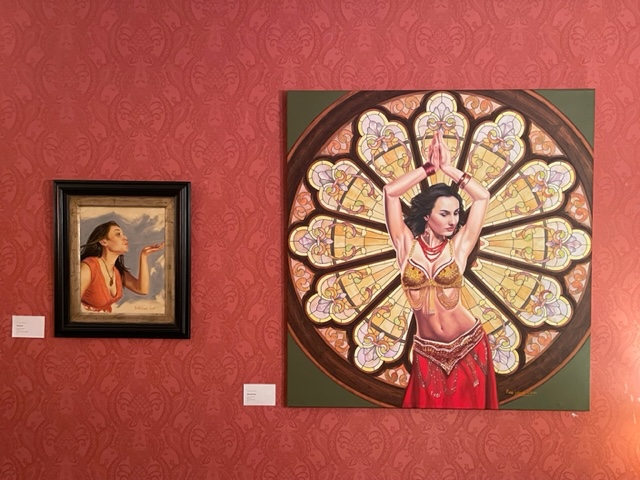
Friends and family also feature in some of his works. “This one, called ‘Radiant,’ has won a Best in Show award,” Wilson says. “This was painted in preparation for a mural that I was selected to paint; the full size painting is in the La Crescenta Library. The model is my niece; I set her up in the studio, moved some lighting around and I took pictures. It’s also one of my favorite paintings; I think it came out really nicely.”

Pointing to the next piece, Wilson says, “This is a fun painting of my son. I painted him with a bloody nose because I thought that would make it more interesting. There’s a favorite Norwegian painter of mine named Odd Nerdrum who painted self-portraits and there’s one of him with a bloody nose, which I find fascinating. I think it depicts life and vulnerability. In this particular instance, my son was getting to that age where he’s going from being a boy into becoming an adult. And men go through this phase when they can play sports, or go into the mountains, whereas as a child he’s fearful and dependent on someone else for protection. It’s a transitional point when they’re proud of the fact that they can take care of themselves. This one gets mixed reviews. When I showed it in a group exhibition I told one woman that I punched my son to make his nose bleed; she was terrified and she wouldn’t speak to me. And then I told her I was joking.”
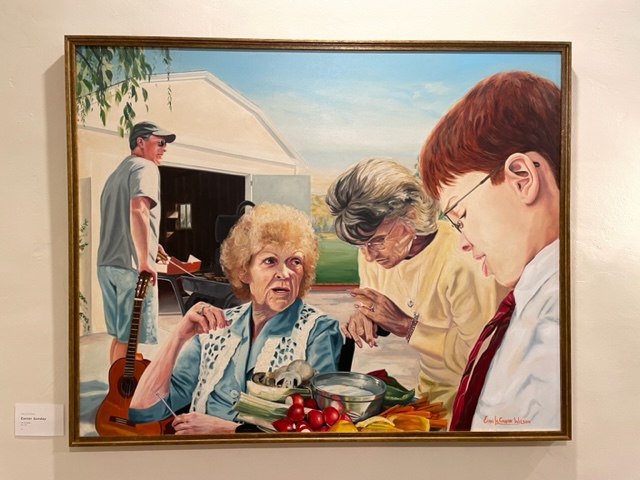
Wilson tends to put some things in a painting that weren’t originally there (like the blue vase in the “Ancient Prague”), as he did for a piece called “Easter Sunday.” He explains, “The people in this painting haven’t even met each other. This piece started out being about these two women chatting. I liked the idea of expanding the scene and making it about an activity, like a Sunday afternoon barbecue with the family. This is my brother on the left and my nephew on the right, and neither one of them has met the two women. In this scene, the red hair is counterbalanced by the guitar and the blue of the sky with her blue shirt. And the vegetable tray coming at you on the foreground isn’t taking away from the conversation that’s going on between the women. All the elements in the painting support that focus.”
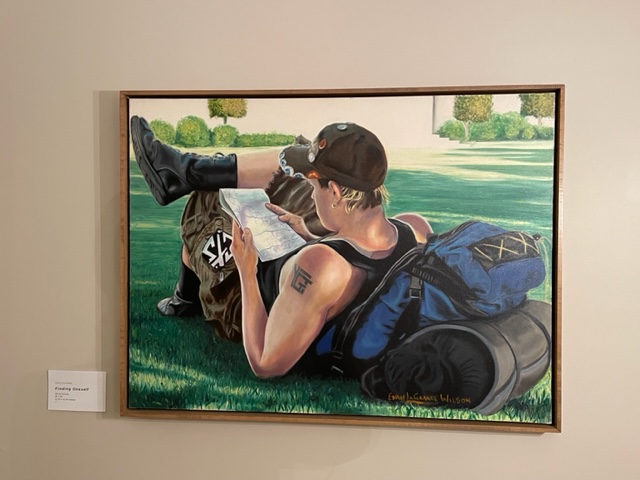
Neither is Wilson shy to approach people he doesn’t know. He relates, “This one is a successful exercise in perspective. Again this is one of those situations where I was driving around and taking photos of something that would work well in a painting. I had in mind a piece about finding yourself and I came across this guy on the campus of Pasadena City College and I asked him to pose for me. He was with a group traveling from somewhere in the Midwest, maybe Oklahoma, and they were just resting on the lawn.”
Likewise, LeGrande Studios is known for decorative arts projects and some of them have been featured in acclaimed publications, including Architectural Digest. Wilson says, “A large portion of my business is what I call site-specific decorative painting where someone will ask me to redesign a room — paint the walls or the ceiling, or paint architectural elements that fit a certain look: maybe it’s a color palette, a design, or a period in a historic home. We work out all the details beforehand and also as we move through the project. Sometimes the commission comes through an interior designer, an architect, or even a friend who tells me ‘I want you to meet with this client.’ Many times I wouldn’t know who I’m painting for, only to find out later that it was a princess from Saudi Arabia.”
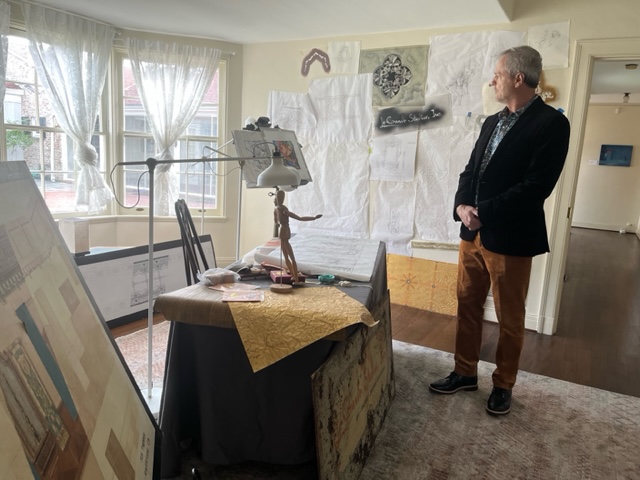
One can’t help but wonder if his middle name is something he made up and Wilson assures that it isn’t. “LeGrande is really the middle name my parents gave me and the only reason I use it professionally is because there is another older gentleman who’s also an artist — a very good artist — named Evan Wilson. And early on I didn’t want to be confused with him. So I used LeGrande also for my business; it’s not about me feeling grand or big.”
Asked what kind of a painter he is, Wilson replies, “I’m a versatile painter and it’s one of the things I’m most proud of; I’m not just a portrait, or landscape, or genre painter. I like painting a lot of different things. I look for meaning in my work. Each one of us has a gesture we put out into the world — whether we’re writing a song, making a bouquet of flowers to give to someone. And what I want is to be a painter that puts interesting things out there into the world based on my experience and what I like. If I try to do something that everyone will love then I’m not going to succeed. When I paint on canvas, it has to be interesting to me, first and foremost, and if it’s interesting to me, hopefully others will find it interesting as well.”
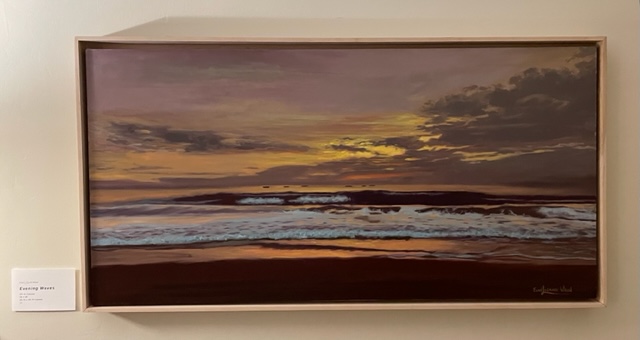
Is he then making a statement? “It can be said that I’m making a statement,” Wilson says. “However, I’m not a political painter. I have strong opinions about some issues — like the environment, or health care, or the government — but that’s not what I paint. I paint to make a statement of beauty: this is what I find interesting in a beautiful way. Because beauty is only a part of the human experience. I have paintings that make statements about youth and beauty; and I find beauty in painting old people who are far past their prime or in the old tree which has been around for several hundred years. My statements are sometimes hidden and sometimes overt. But, at the end of the day, it’s about what I find interesting. And that sometimes changes through time.”
Lastly, I ask if there’s something he wants to add, and he quickly states, “I just want to say thank you to anyone who takes the time to sit in front of the painting and appreciate it because a lot of work goes into these paintings. It’s an art form. It’s not the most important art form in the world, it’s only part of the human experience — but appreciation of it enhances our life. It’s made by hand, it’s a craft that I have worked on for years and so I’m glad when people take notice. I do it for myself but I also do it as a business and for the enjoyment of others.”

